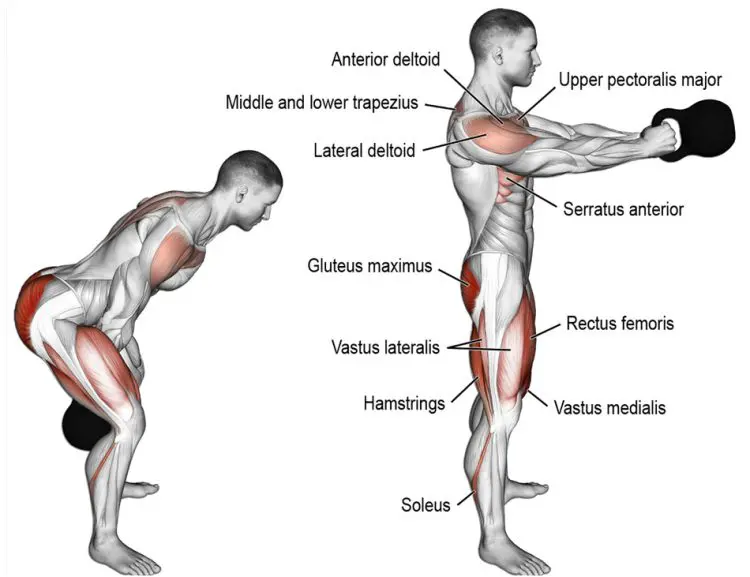A kettlebell is a cast-iron or cast-steel ball with a handle attached to its top and resembles a cannonball with a handle. The versatile training equipment can be used for a variety of exercises, which can boost explosive strength, cardiovascular health, and mobility.
Although kettlebell swings have been popular for a long time, they entered the mainstream since functional training regimens like CrossFit exploded onto the scene.
Since kettlebell swings require minimal equipment (just one kettlebell), it makes the exercise more convenient and gives you the freedom to perform the movement in your home gym or backyard.
Furthermore, kettlebell swing challenges became a thing during the COVID-19 lockdowns when people were desperately looking for ways to keep themselves active and fit while curled up inside their homes.
Performing 100 kettlebell swings a day is no joke. The kettlebell swing is one of the exercises that looks super easy but will leave you exhausted by the time you are done with it, or it is done with you, depending on how you look at it.
Remember, if you embark on the 100 kettlebell swings a day challenge, you need to stick with it for at least a month to see any favorable changes in your physique.
Level Up Your Fitness: Join our 💪 strong community in Fitness Volt Newsletter. Get daily inspiration, expert-backed workouts, nutrition tips, the latest in strength sports, and the support you need to reach your goals. Subscribe for free!
Check Out: Calories Burned Using Kettlebell Training Calculator
13 Benefits of Performing 100 Kettlebell Swings a Day
Here are the benefits of performing 100 kettlebell swings a day:

1. Low-Risk Exercise To Learn the Hip-Hinge Movement Pattern
Kettlebell swings are a great exercise for beginners who want to build a strong foundation for hip-hinge exercises like the deadlift and squat by improving their strength and endurance.
2. Full-Body Exercise
Kettlebell swings are a full-body compound exercise that recruits upper and lower body muscles and can help improve your conditioning and make the fat melt off your body. Plus, the exercise is great for people who cannot find the time to train every muscle group separately every day.
Although the kettlebell swing is a full-body hip-hinge movement, it is relatively easy to perform and master. Additionally, the built-in momentum is your friend, and the exercise gets especially easy once you catch the movement rhythm.
3. Naturally Boosts Testosterone and Growth Hormone Levels
Testosterone and human growth hormone (HGH) are produced naturally inside the human body. Testosterone is the male sex hormone that helps regulate sex drive (libido), bone mass, fat distribution, muscle mass and strength, and the production of red blood cells and sperm; growth hormone influences your height and helps build bones and muscles.
It is no secret that the two hormones are popular in the bodybuilding and fitness community and are used by athletes to improve their performance and physique aesthetics.
A 2014 study conducted on 10 men indicated that performing 12 rounds of 30 seconds of 16 kg kettlebell swings alternated with 30 seconds of rest helped improve the subjects’ natural testosterone and growth hormone levels. [1]
4. Helps Build Gluetal Strength
Glutes are the strongest muscle group in the body and play a vital role in your overall strength, explosiveness, and body posture. Performing 100 kettlebell swings a day will help build explosive strength and improve your mobility.
5. Improves Balance
Kettlebell swings are inherently an explosive exercise and require you to blast off to the top of the movement and return to the starting position with a slow and controlled motion.
Performing the exercise requires you to shift your weight between your toes and heels throughout the movement, which can help improve your balance. Plus, kettlebell swings stimulate the biomechanics of running and jumping and can improve your agility and coordination.
6. Works the Entire Posterior Chain
Electromyography-based research suggests kettlebell swings work the posterior chain muscles, including the lower back, glutes, hamstrings, and rear delts to a greater degree than other kettlebell exercises. [2]
7. Improves Your Posture
Many people, especially those with a desk job, spend most of their days hunched over a computer, resulting in a rounded back and hunched shoulders.
Kettlebell swings are a posterior chain exercise and can help improve your posture by reversing the damage and forcing you to maintain a straight spine and tight core.
Level Up Your Fitness: Join our 💪 strong community in Fitness Volt Newsletter. Get daily inspiration, expert-backed workouts, nutrition tips, the latest in strength sports, and the support you need to reach your goals. Subscribe for free!
8. Convenience
Since the exercise only requires a single kettlebell, you can make the equipment a part of your garage gym without breaking your bank. Kettlebell swings require minimal space and can be performed in a corner in your home or garage.
Furthermore, even if you train at a commercial gym during rush hours, finding a kettlebell for the exercise shouldn’t be a problem. Most gyms have multiple sets of kettlebells.
9. Great For Cardiovascular Health
If you train at home but do not own sophisticated cardio equipment, performing a hundred reps of the kettlebell swings can be an effective replacement.
Performing 100 kettlebell swings with little to no rest between reps will spike your heart rate and help burn off calories, keeping your cardiovascular health in check.
10. Engages and Strengthens Your Core
As per a study, the kettlebell swing is effective at keeping the abdominals and other core muscles engaged throughout the movement. [3]
Compared to dumbbells, kettlebells are relatively unstable and require constant core engagement to balance the weight. Do not be surprised if your abs are sore for a couple of days after performing the exercise for the first time.
11. Enhances Endurance and Stamina
Performing 100 kettlebell swings a day demands endurance and stamina. While you might begin your kettlebell swing program by breaking down the hundred reps into several sets, your objective should be to improve your muscular and cardiovascular endurance and strength so you can perform the recommended reps in one go.
12. Can Help Your Weight Loss Progress
While fixing your diet should be your first objective if you’re on a weight loss regimen, performing a high-intensity exercise like kettlebell swings can improve your results by boosting your heart rate and burning calories.
As per a study, a 20-minute kettlebell swinging session, consisting of around 400 kettlebell swings, burns roughly 400 calories, meaning a 100 swing kettlebell session, which can be 7 to 10 minutes or less, can burn around 100 calories. [4]
The kettlebell swing is a great exercise, especially if you are running a calorie deficit. You could easily change the number of kettlebell swings reps or time to match your calorie goal.
Must Read: How to Lose 20 Pounds in a Month
13. Improves Lower Back Health
Your lower back and hamstrings take the most beating during the exercise. Performing 100 kettlebell swings a day requires some getting used to, and you might experience a sore lower back for the first couple of times you do the exercise.
Furthermore, compressed discs are one of the most common causes of lower back pain, and doing the kettlebell swings regularly can help fix it. Swinging back and forth during the exercise can help the spinal discs separate and return to a natural position and alleviate the stress and pain.
Are 100 kettlebell swings a day enough for overall fitness and health?
As mentioned above, 100 kettlebell swings can be completed within 7 to 10 minutes. However, per the U.S. Department of Health and Human Services, an average adult needs 150 minutes of exercise a week (25 minutes six days a week) for optimal health.
Do not worry; you don’t need to head to the gym for the remaining 15 minutes of training. You could perform the kettlebell exercises mentioned below to meet your daily 25-minute physical activity quota:
- Kettlebell Hammer Curl
- Kettlebell Hang Clean
- Kettlebell Seesaw Press
- Kettlebell Sumo High Pull
- Kettlebell Turkish Get Up
- Kettlebell One-Arm Row
- Kettlebell Front Squat
- Kettlebell Windmill
- Kettlebell Figure 8
How to Do the Kettlebell Swing
Knowing the benefits of performing kettlebell swings isn’t enough. You need to follow the correct form while performing the movement to make the most of the exercise.

This is how to perform a kettlebell swing with the correct form:
- Stand upright with a shoulder-wide stand.
- Hold a kettlebell by its handle with both hands with an overhand grip.
- Assume a hinged position with your knees slightly bent, chin tucked, and weight centered over your foot.
- While keeping your arms extended, squeezing your shoulder blades together, and engaging your core, swing the weight backward between your legs.
- While shifting the weight onto your heels, lower your butt back and down toward the wall behind you.
- Driving through your heels, push your hips forward explosively, and send the weight swinging upward from your quads until it is at chest height.
- Your body should be in a straight line at the top of the movement.
- Pause and contract your core and glutes at the top.
- Return to the starting position with a slow and controlled motion while shifting your weight back onto your heels and hinging at your hips.
- Repeat for the recommended reps.
FAQs
Can I do 100 Kettlebell Swings a Day?
Yes, you can perform kettlebell swings every day. However, it is recommended that you take at least a day off during the week to allow your body ample time to rest and recuperate.
How heavy should the kettlebell be?
If you train at a gym, a beginner could begin with the lightest kettlebell available. On the other hand, more experienced lifters could test their endurance by lifting the same weight they do during a warm-up set on the dumbbell shoulder front raise.
Can I add the 100 kettlebell swings to my weight training regimen?
Yes, you can perform the hundred swings at the end of your workout as a finisher. Doing the exercise at the beginning of your weight training routine can result in muscle fatigue, which can hamper your resistance training session.
Wrapping Up
While performing 100 kettlebell swings a day might sound overwhelming — which it will be during the initial phase — sticking with the practice will get you stunning results.
Whether you’re a beginner, intermediate, or advanced lifter, a strongman, CrossFitter, powerlifter, or bodybuilder, you can make space for kettlebell swings in your training regimen. The strength, agility, explosiveness, and balance gains will be worth it.
References
- Budnar RG Jr, Duplanty AA, Hill DW, McFarlin BK, Vingren JL. The acute hormonal response to the kettlebell swing exercise. J Strength Cond Res. 2014 Oct;28(10):2793-800. doi: 10.1519/JSC.0000000000000474. PMID: 24714543.
- Lyons, B.C., Mayo, J.J., Tucker, W.S., Wax, B., & Hendrix, R.C. (2017). Electromyographical Comparison of Muscle Activation Patterns Across Three Commonly Performed Kettlebell Exercises. Journal of Strength and Conditioning Research, 31, 2363–2370.
- Andersen, V., Fimland, M.S., Gunnarskog, A., Jungård, G., Slåttland, R., Vraalsen, Ø., & Saeterbakken, A.H. (2016). Core Muscle Activation in One-Armed and Two-Armed Kettlebell Swing. Journal of Strength and Conditioning Research, 30, 1196–1204.
- Farrar, Ryan E; Mayhew, Jerry L; Koch, Alexander J Oxygen Cost of Kettlebell Swings, Journal of Strength and Conditioning Research: April 2010 – Volume 24 – Issue 4 – p 1034-1036. doi: 10.1519/JSC.0b013e3181d15516









